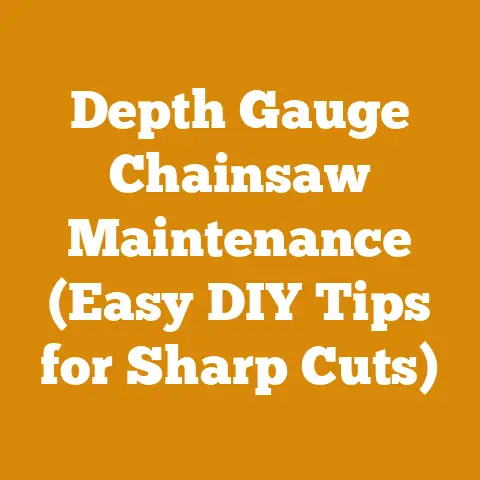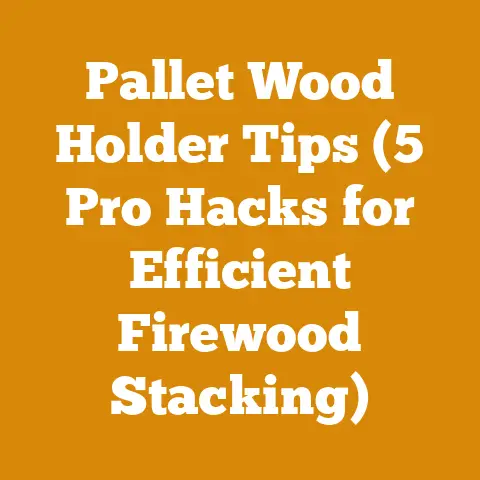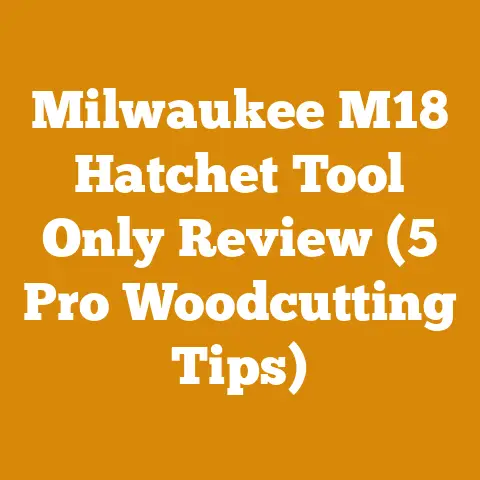How to Price Stump Grinding (5 Pro Tips for Arborists)
Imagine this: you’ve just finished a tree removal job. The customer is happy, the site is clear…except for that unsightly stump. It’s sitting there like a stubborn reminder of the tree that once was, and now you have to figure out how to price the stump grinding service. Getting it wrong can mean leaving money on the table or, worse, losing the job altogether. I’ve been there, trust me. Pricing stump grinding isn’t just about pulling a number out of thin air; it’s about understanding your costs, your market, and the specific challenges of each job.
In my years in the tree care industry, I’ve seen countless arborists struggle with this exact problem. That’s why I’ve put together these five pro tips to help you confidently price stump grinding and ensure you’re running a profitable and sustainable business. Let’s dive in!
How to Price Stump Grinding: 5 Pro Tips for Arborists
Pricing stump grinding effectively is a blend of art and science. It’s about balancing your costs, understanding the market, and accurately assessing the unique challenges of each job. Here are five proven strategies I’ve learned over the years to help you nail your pricing.
1. Know Your Costs: The Foundation of Profitable Pricing
Before you can even think about what to charge, you need a crystal-clear understanding of your costs. This isn’t just about the obvious expenses like fuel and labor; it’s about digging deep and uncovering all the hidden costs that can eat into your profits.
-
Equipment Costs: This is a big one. Stump grinders aren’t cheap. Whether you own your grinder or rent it, you need to factor in the associated costs.
- Depreciation: If you own your grinder, you need to account for depreciation. A good rule of thumb is to depreciate your equipment over 5-7 years, depending on usage and maintenance. Calculate the annual depreciation cost and then divide it by the number of jobs you expect to do in a year to get a per-job depreciation cost.
- Maintenance and Repairs: Stump grinders take a beating. Teeth need replacing, belts break, and engines require servicing. I recommend setting aside at least 10-15% of the grinder’s original purchase price annually for maintenance and repairs. Keep a detailed log of all maintenance expenses.
- Rental Fees: If you rent, factor in the daily or hourly rental rate, plus any additional charges for transportation or insurance.
-
Labor Costs: Don’t underestimate the cost of labor. It’s not just about the hourly wage you pay your employees; it’s about the total cost of employing them.
-
Wages: Include the hourly wage for each person involved in the job.
- Benefits: Add the cost of benefits, such as health insurance, paid time off, and retirement contributions.
- Payroll Taxes: Factor in employer-paid payroll taxes, such as Social Security, Medicare, and unemployment insurance.
- Workers’ Compensation: This is a crucial expense in the tree care industry. The cost of workers’ compensation insurance can vary significantly depending on your state and your company’s safety record.
-
Transportation Costs: Getting your equipment and crew to the job site costs money.
-
Fuel: Track your fuel consumption for each job.
- Vehicle Maintenance: Factor in the cost of maintaining your trucks and trailers.
- Insurance: Include the cost of vehicle insurance.
-
Overhead Costs: These are the costs that keep your business running, regardless of how many jobs you do.
-
Office Rent: If you have an office, include the cost of rent or mortgage payments.
- Utilities: Factor in the cost of electricity, water, and gas.
- Insurance: Include the cost of general liability insurance.
- Marketing and Advertising: Don’t forget to budget for marketing and advertising expenses.
- Software and Subscriptions: CRM software, accounting software, and other online tools can add up.
-
Disposal Costs: Depending on your area, you may need to pay to dispose of the stump grindings.
-
Landfill Fees: Check with your local landfill for their disposal rates.
- Transportation Costs: Factor in the cost of transporting the grindings to the landfill.
Example: Let’s say you’re pricing a job in a suburban neighborhood. You own a mid-sized stump grinder that you purchased for $10,000 five years ago. Here’s a breakdown of your estimated costs:
- Equipment Depreciation: $10,000 / 5 years = $2,000 per year. Assuming you do 100 stump grinding jobs per year, that’s $20 per job.
- Equipment Maintenance: $1,000 per year (10% of purchase price). That’s $10 per job.
- Labor: 2 workers x $25/hour x 4 hours = $200
- Labor Benefits & Taxes: 25% of labor cost = $50
- Transportation: $50 (fuel, vehicle wear and tear)
- Disposal Fees (if applicable): $25
Total Estimated Costs: $20 + $10 + $200 + $50 + $50 + $25 = $355
This means that, at a bare minimum, you need to charge more than $355 to break even on this job. And that doesn’t even include overhead costs or profit!
Actionable Takeaway: Create a detailed spreadsheet to track all of your costs. Review it regularly to ensure your pricing is accurate and profitable. This is the cornerstone of a sustainable business.
2. Understand Your Market: Know Your Competition and Customer
Once you have a firm grasp on your costs, the next step is to understand your market. This means knowing your competition, understanding your customers, and identifying your unique selling proposition.
- Research Your Competition: Find out what other arborists and tree care companies in your area are charging for stump grinding. Call them, check their websites, and read online reviews. This will give you a good sense of the going rate in your market.
- Secret Shopping: I’ve even had friends call competitors posing as potential customers to get pricing information. It sounds a bit sneaky, but it’s a common practice in many industries.
- Understand Your Customers: Who are your ideal customers? Are they homeowners, property managers, or commercial businesses? What are their priorities? Are they primarily concerned with price, or are they willing to pay more for quality and reliability?
- Customer Surveys: Consider sending out customer surveys to gather feedback on your pricing and services. This can provide valuable insights into what your customers value.
- Identify Your Unique Selling Proposition (USP): What makes your business different from the competition? Do you offer faster service, better customer service, or a more environmentally friendly approach? Highlight your USP in your marketing materials and sales presentations.
- Specialized Services: In my experience, offering specialized services like grinding stumps below grade for replanting or providing detailed site restoration can justify a higher price.
- Consider Seasonal Demand: Stump grinding demand often fluctuates with the seasons. Expect higher demand in the spring and fall, and adjust your pricing accordingly.
- Promotions: During slower periods, consider offering discounts or promotions to attract customers.
Example: Let’s say you’re in a competitive market with several other tree care companies offering stump grinding services. After doing some research, you find that the average price for grinding a 24-inch diameter stump is around $150. However, you also discover that many customers are complaining about the lack of communication and professionalism from these companies.
You decide to differentiate yourself by offering exceptional customer service, prompt communication, and a satisfaction guarantee. You also invest in high-quality equipment and training to ensure that you can handle even the most challenging stump grinding jobs.
As a result, you’re able to charge a premium price of $200 for a 24-inch stump, and customers are willing to pay it because they value the peace of mind that comes with knowing they’re working with a reputable and reliable company.
Actionable Takeaway: Conduct thorough market research to understand your competition, your customers, and your unique selling proposition. Use this information to position your business effectively and justify your pricing.
3. Choose Your Pricing Model: Finding the Right Fit
There are several different pricing models you can use for stump grinding. The best model for your business will depend on your costs, your market, and your preferences. Here are some of the most common options:
-
Per-Inch Pricing: This is the most common pricing model for stump grinding. You charge a set rate per inch of stump diameter, measured at the widest point.
- Pros: Simple to calculate and easy to understand.
- Cons: Doesn’t account for stump height, root flare, or accessibility.
- Example: $5-$10 per inch of diameter. A 24-inch stump would cost $120-$240.
-
Per-Stump Pricing: You charge a flat rate for each stump, regardless of its size.
-
Pros: Simple and predictable.
- Cons: Can be difficult to price accurately, especially for large or complex stumps.
- Example: $100-$300 per stump, depending on size and complexity.
-
Hourly Pricing: You charge an hourly rate for your time.
-
Pros: Can be a good option for complex or time-consuming jobs.
- Cons: Can be difficult to estimate the total cost upfront, which can make customers nervous.
- Example: $100-$200 per hour, plus equipment costs.
-
Minimum Charge: Set a minimum charge to cover your fixed costs, even for small jobs.
-
Pros: Ensures you’re not losing money on small jobs.
- Cons: Can deter customers with very small stumps.
- Example: $75 minimum charge, even if the stump is only a few inches in diameter.
-
Combination Pricing: Use a combination of pricing models to create a more customized and accurate quote.
-
Pros: Allows you to account for a variety of factors, such as stump size, accessibility, and complexity.
- Cons: Can be more complex to calculate and explain to customers.
- Example: A base rate of $50, plus $5 per inch of diameter, plus an additional charge for difficult access.
My Preference: I generally prefer a combination of per-inch pricing and a minimum charge. This allows me to be competitive on smaller jobs while still ensuring that I’m compensated fairly for larger, more complex stumps. I also factor in accessibility and complexity when providing a quote.
Example: You’re pricing a job with three stumps: one is 12 inches in diameter, one is 24 inches in diameter, and one is 36 inches in diameter. You use a per-inch pricing model of $7 per inch, with a minimum charge of $75.
- 12-inch Stump: $7 x 12 inches = $84. Since this is above your minimum charge, the price is $84.
- 24-inch Stump: $7 x 24 inches = $168.
- 36-inch Stump: $7 x 36 inches = $252.
Total Price for the Job: $84 + $168 + $252 = $504
Actionable Takeaway: Experiment with different pricing models to find the one that works best for your business. Be transparent with your customers about how you calculate your prices.
4. Assess the Job: The Devil is in the Details
Before you provide a quote, it’s essential to carefully assess the job site. This will help you identify any potential challenges and ensure that your pricing is accurate.
-
Stump Size and Type: Measure the diameter of the stump at its widest point. Also, consider the type of tree. Hardwoods like oak and maple can be more difficult to grind than softwoods like pine and fir.
- Wood Density: The Janka hardness scale measures the resistance of wood to denting and wear. Knowing the Janka hardness of the tree species can help you estimate the time and effort required to grind the stump.
- Stump Height and Root Flare: A tall stump or a large root flare will require more grinding.
-
Accessibility: Is the stump easily accessible, or is it located in a tight space or on a steep slope? Difficult access can significantly increase the time and effort required to complete the job.
-
Equipment Limitations: Consider the size and maneuverability of your stump grinder. Can you get it into the location without damaging the surrounding landscape?
-
Obstacles: Are there any obstacles around the stump, such as fences, walls, or underground utilities?
-
Utility Locates: Always call 811 before you dig to locate any underground utilities. This is not only the law but also a crucial safety precaution.
- Soil Conditions: Is the soil rocky, sandy, or clay? Rocky soil can damage your stump grinder teeth and slow down the grinding process.
-
Desired Grinding Depth: How deep does the customer want the stump ground? Grinding below grade for replanting will require more time and effort.
-
Replanting Considerations: If the customer plans to replant in the same location, you’ll need to grind the stump deep enough to allow for root growth.
-
Cleanup: Who is responsible for cleaning up the stump grindings? If you’re responsible, factor in the cost of labor and disposal.
-
Grinding Utilization: I once worked on a project where we used the stump grindings as mulch for the surrounding landscaping. This not only saved on disposal costs but also provided a valuable service to the customer.
Example: You’re pricing a job in a backyard with limited access. The stump is 30 inches in diameter and located next to a fence. The soil is rocky, and the customer wants the stump ground 12 inches below grade for replanting.
Because of the limited access, rocky soil, and desired grinding depth, you know that this job will take longer and be more difficult than a typical stump grinding job. You adjust your pricing accordingly, adding a premium for the additional time and effort required.
Actionable Takeaway: Take the time to carefully assess each job site before providing a quote. This will help you identify any potential challenges and ensure that your pricing is accurate.
5. Communicate Clearly: Transparency Builds Trust
Clear and transparent communication is essential for building trust with your customers and avoiding misunderstandings.
- Provide a Detailed Quote: Your quote should clearly outline the scope of work, the price, and any additional charges.
-
Explain Your Pricing: Be prepared to explain how you calculate your prices. Customers appreciate transparency and are more likely to trust a company that is upfront about its pricing.
- Justification: I always explain to my customers that my pricing reflects the cost of equipment, labor, insurance, and other overhead expenses.
- Set Expectations: Clearly communicate what the customer can expect from the stump grinding process, including the amount of noise, dust, and debris.
- Address Concerns: Be responsive to customer questions and concerns. Address any issues promptly and professionally.
- Get it in Writing: Always get your agreement in writing. This will protect you in case of any disputes.
Example: You provide a customer with a quote for stump grinding. The quote includes the following:
- Stump grinding of one 24-inch diameter stump
- Grinding to a depth of 6 inches below grade
- Cleanup of stump grindings
- Total price: $200
You also explain to the customer that the price includes the cost of equipment, labor, insurance, and disposal. You also inform them that the stump grinding process will generate some noise and dust.
Actionable Takeaway: Communicate clearly and transparently with your customers. This will build trust and help you avoid misunderstandings.
Bonus Tip: Always follow up with your customers after the job is complete to ensure they are satisfied with your work. This is a great way to build relationships and generate repeat business.
A Final Thought: Pricing stump grinding is an ongoing process. As your costs change, your market evolves, and your skills improve, you’ll need to adjust your pricing accordingly. Don’t be afraid to experiment and find what works best for your business. And remember, the key to success is to provide value to your customers and build a reputation for quality and reliability.
By following these five pro tips, you can confidently price stump grinding and ensure that you’re running a profitable and sustainable business. Good luck!






